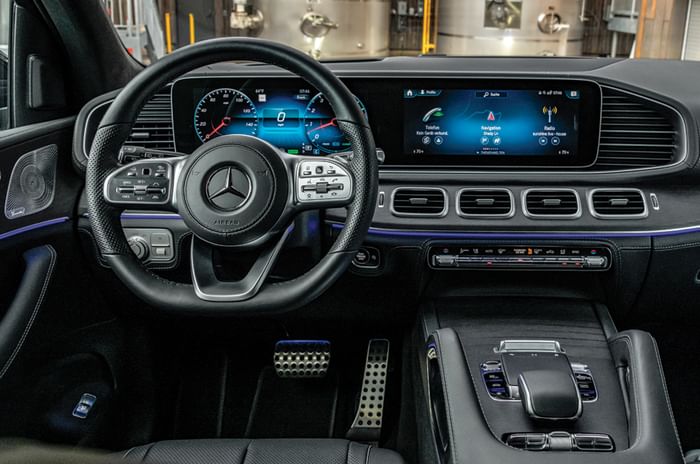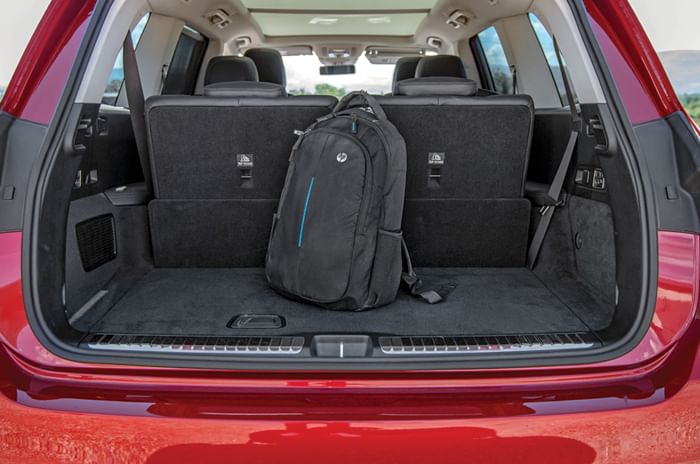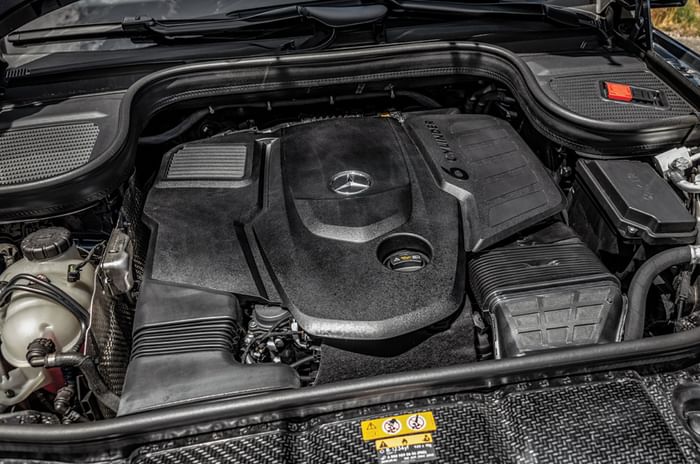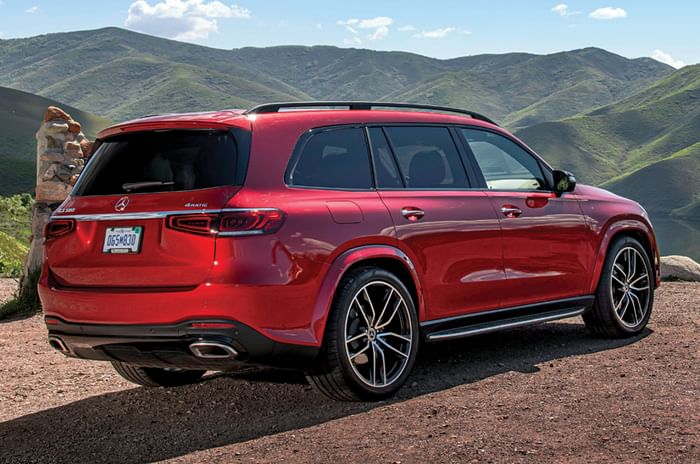Utah in the United States really does feel like the perfect backdrop for the new GLS. It’s a picturesque land of wide, open spaces with enough terrain to make an off-road enthusiast weep, but also gargantuan freeways and a few small B roads winding around the lakes. It’s also home to the fabled Bonneville Salt Flats, and just about everything – from the food to the wildlife – is supersized, so I’m feeling right at home moseying around in this 5.2m-long luxury Panzer tank. But, apparently, it’s not just about the size this time. They’re calling it ‘the S-class of SUVs’ – a very big call to make – and while I’m usually quick to dismiss that as a bunch of marketing faff, this time, I think they might be on to something.
What’s the 2020 Mercedes-Benz GLS like on the inside?
Not that the outgoing GLS was ever lacking in the luxury department; it’s just that, in this new one, it all feels far better integrated and less tacked on. The dashboard, shared with the smaller GLE, does well to look nothing like the ones from Merc’s sedan range, with the dual 12.3-inch infotainment screens housed in what looks like the unit in your living room that houses your TV – only better built. Another standout design element on the dashboard is the squared-off adaptation of the S-class’ four central AC vents, which suit this car much better.

Interior quality and the materials used, as ever, are top drawer, with the characteristic use of brushed aluminium switchgear, and there’s selectable colourful ambient lighting pouring out of everywhere, even the grab handles on the centre console. Speaking of the centre console, it’s the usual V-shaped control layout for various vehicle functions, like drive mode selection, volume and raising the air suspension (also the off-road controls if you’ve equipped the off-road pack on your car). However, if you’re used to today’s Mercs, what’s missing is the click-wheel controller for the infotainment system; they’ve done away with it for the new MBUX infotainment system, and you get a less intuitive touchpad instead. The plush, leather wrapped front seats offer a wide array of adjustment (and heating, cooling and massage functions), which is enough for even someone as vertically challenged as me to get a commanding view of the massive bonnet ahead.
But a true luxury car, especially in the Indian context, does its best work in the second row – and a GLS has to go further still, with its third row. You can have one of three seat options in the GLS, all of which are power-adjusted, incidentally. The most basic is a regular three-seat bench, which is very comfy as you might expect, and ideal if you plan to use your GLS as a proper family car. Then there are the ones you see here – a pair of captain chairs, which too offer a good amount of comfort and adjustment. Then there’s the full-on split bench with a centre console in the middle, complete with wireless charging and a touchscreen tablet controller for just about everything. You even get optional touchscreen infotainment screens for rear passengers. You can specify heating, cooling and massage functions for these seats too, and although they’re all very plush, they’re not quite at the same ultimate level of comfort an S-class’ back seat delivers. And how could they be – when they also have to split and fold to give access to the third row. Perhaps we’ll have to wait for the planned Maybach GLS, that’s rumoured to be just a 4-seater.

This split/fold, as with everything else, is powered, and quite slow; for once, you’ll miss the convenience of a manual one-lever flip like you got on the previous GLS. Like most big SUVs, it’s a bit of a climb-and-duck situation getting in, but once you’re in place, these come close to being the most spacious and comfiest third-row seats around. You’re sat a bit knees-up, of course, and legroom depends on how you’ve set the middle row, but head- and shoulder-room are rather impressive. Passengers here get their own speakers, charging ports and cup holders, and even the option of their own fifth climate ‘zone’ for the air conditioner.
It’s even got plenty of boot space – 355 litres – with all three rows up, enough for a few medium-sized suitcases. Fold the second and third rows and the capacity is a truly insane 2,400 litres. Loading is made easier by air suspension that can be lowered at the touch of a button in the boot, as well as other buttons that can raise and lower the seats individually.

There’s no shortage of gizmos on this car. Radar-based everything with semi-autonomous driving, collision avoidance, lane keeping and various other driving aids. There are gesture controls for the infotainment and connected features – including an AI-driven voice assistant that responds to more casual commands – and, of course, the usual smattering of kit you’d expect, like 360-degree cameras, auto parking, a head-up display, wireless charging and then some.
What’s the 2020 Mercedes-Benz GLS like to drive?
This particular Designo Cardinal Red car is a GLS 580, which uses a 490hp/700Nm, 4.0-litre turbo-petrol V8 and pairs it with a 48V mild-hybrid system that serves up an additional 22hp and 250Nm of torque when it deems necessary! We won’t be getting this engine, at least not at launch, but it will likely go into the Maybach version. The ones we will get are six-cylinder petrol and diesel versions; and luckily, we drove those as well.
The GLS 450 petrol we drove used a turbocharged 3.0-litre straight-six that makes 367hp and 500Nm of torque. This, like the 580, had a mild-hybrid system adding (you guessed it) 22hp and 250Nm torque, when necessary. I say ‘the one we drove’ because the Indian GLS 450 might use a different powertrain. Like the Indian S-class, it could continue with the old-gen 3.0-litre V6 turbo-petrol (which is already BS-VI-compliant) as this will save them the cost of bringing in an all-new engine; but we’ll just have to wait and see.

It would be nice if they did bring the new straight-six, however. It’s quite rev-happy and sounds nice when you open it up. The rest of the time it remains silent, just whooshing along in the background. And just when you think it might not have enough power for a car this big, that extra fillip of electric boost comes in to nudge you gently forward. 0-100kph is dealt with in a claimed 6.2sec, which is super-quick for what is the ‘entry-level’ engine.
The engine that matters most, however, is the straight-six diesel, because even though people are gradually moving toward petrol power again, in a big SUV like this, diesel is still more popular. And so it should be, because this engine feels so much better suited to a vehicle this big. It’s not just the GLS 400d’s 330hp and 700Nm, but the fact that all that torque is available from as early as 1,200rpm that makes all the difference. You’re never more than a toe’s flex away from getting the GLS to hook-up and take off, with 0-100kph taken care of in a claimed 6.3sec, and credit must also go to the latest version of Merc’s 9G-tronic torque-converter auto gearbox for always being on the ball. It doesn’t even give that much away to the petrol in terms of refinement, and it too sounds quite pleasant when you rev it out. Again, however, it remains to be seen if this is the one we get in India; like the S-class, we may just get this unit’s lower state of tune – the 350d with 286hp and 600Nm of torque.
At first encounter, the GLS feels its size. Though the power-assistance takes away any effort from steering it, you’re always watching your mirrors and peering around the A-pillars while trying to manoeuvre at low speeds. However, as you pick up the pace, the electronics do an incredible job of disguising its bulk – given you have enough room, and here in Utah we certainly do. It’s all thanks to E-ABC (Active Body Control) which, with the help of the 48V electrical system can control each wheel’s suspension independently and almost instantaneously. Not only is body roll eerily well-contained, the car can even counter-lean into corners by 3 degrees to keep your passengers less nauseated when you want to have a bit of fun.
Is the 2020 Mercedes-Benz GLS worth waiting for?
We’ve had seven-seat luxury SUVs in India for some time, but it’s really the GLS (formerly GL) that’s always pushed the segment the furthest, be it on size and space (especially in the third row) and even luxury, and that’s because it always had the GLE (formerly ML) below it. Now that the new GLE has grown so much, and with arch-rival BMW having launched its own impressive seven-seater – the X7 – this segment has gone through the stratosphere.

Space was never an issue, and once again, you’re treated to one of the best third rows in the business and a sizeable boot as well. It’s the luxury that’s the real draw this time around, and though it’s not quite as good as an S-class limousine, it comes shockingly close. Then there’s the tech, which goes above and beyond what you’d expect from – or what you’d ever use in – such a vehicle, which applies to its off-road ability too; but hey, it wouldn’t be a flagship model without some excess, right?

SUVs are the way the whole world is going, and while at one end of the market they’re getting smaller and replacing hatchbacks, at this upper end they’re muscling in on the limousines. The prices will match too when it’s launched in early 2020, and though the GLS will continue to be assembled from CKD kits in India, expect it to cost north of a crore, ex-showroom. It delivers on that all-conquering feel its predecessor did, but crucially for our market, it’s a far nicer place to be sat and driven around in, this time.
Click here for Mercedes-Benz GLS prices, reviews, images, videos and more
Click here for Mercedes-Benz India models, prices, reviews, images, videos and more
















































